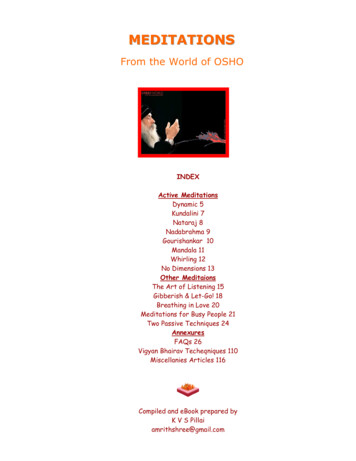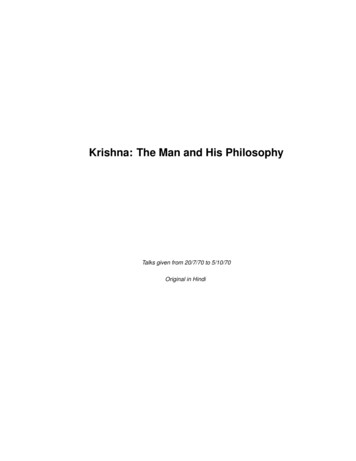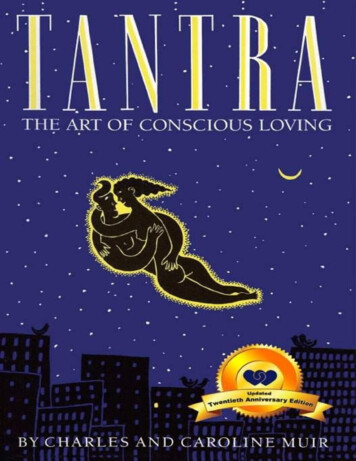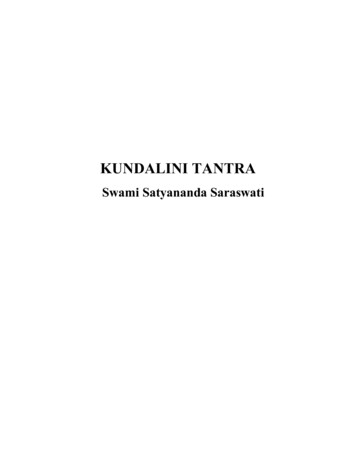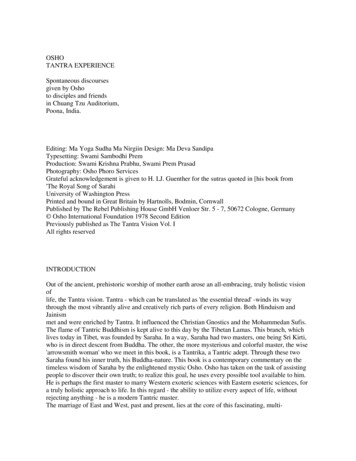
Transcription
OSHOTANTRA EXPERIENCESpontaneous discoursesgiven by Oshoto disciples and friendsin Chuang Tzu Auditorium,Poona, India.Editing: Ma Yoga Sudha Ma Nirgiin Design: Ma Deva SandipaTypesetting: Swami Sambodhi PremProduction: Swami Krishna Prabhu, Swami Prem PrasadPhotography: Osho Phoro ServicesGrateful acknowledgement is given to H. LJ. Guenther for the sutras quoted in [his book from'The Royal Song of SarahiUniversity of Washington PressPrinted and bound in Great Britain by Hartnolls, Bodmin, CornwallPublished by The Rebel Publishing House GmbH Venloer Str. 5 - 7, 50672 Cologne, Germany Osho International Foundation 1978 Second EditionPreviously published as The Tantra Vision Vol. IAll rights reservedINTRODUCTIONOut of the ancient, prehistoric worship of mother earth arose an all-embracing, truly holistic visionoflife, the Tantra vision. Tantra - which can be translated as 'the essential thread' -winds its waythrough the most vibrantly alive and creatively rich parts of every religion. Both Hinduism andJainismmet and were enriched by Tantra. It influenced the Christian Gnostics and the Mohammedan Sufis.The flame of Tantric Buddhism is kept alive to this day by the Tibetan Lamas. This branch, whichlives today in Tibet, was founded by Saraha. In a way, Saraha had two masters, one being Sri Kirti,who is in direct descent from Buddha. The other, the more mysterious and colorful master, the wise'arrowsmith woman' who we meet in this book, is a Tantrika, a Tantric adept. Through these twoSaraha found his inner truth, his Buddha-nature. This book is a contemporary commentary on thetimeless wisdom of Saraha by the enlightened mystic Osho. Osho has taken on the task of assistingpeople to discover their own truth; to realize this goal, he uses every possible tool available to him.He is perhaps the first master to marry Western exoteric sciences with Eastern esoteric sciences, fora truly holistic approach to life. In this regard - the ability to utilize every aspect of life, withoutrejecting anything - he is a modern Tantric master.The marriage of East and West, past and present, lies at the core of this fascinating, multi-
dimensional book. The Royal Song of Saraha, delivered to the king in the middle of a cremationgrounds by the ecstatic Saraha, is so powerful that when the king heard it he was enlightened on thespot. Saraha brings together the Buddha's message of meditation, with the Tantric theme ofunconditional acceptance.Osho's commentary beautifully captures the color, fragrance, the very heart of Saraha'sexperience, of his personal, radical journey, and of his message. On this foundation Osho then addshis own insights, his modern expression of the mystical path. The sutras of Saraha's song alternatewith questions from 20th-century seekers from around the world. Osho's spontaneous responses tothese personal queries form the third layer of the book. And there is yet another, a fourth layer,which exists between the lines'.This is the warm, loving, playful yet poignant and insightful interraction between master anddisciple, between seekers of the path and one who has reached the goal. It is a glimpse into how amystic works and takes us to our very life source in the search for truth. It demonstrates how wordscan take us into silence, and how silence brings us into a direct 'knowing' of the truth.If you are open and available to soak up the flavor of this book, it can propel you on your ownmystical journey into the essence of reality. It is not only a book 'about' a topic, it is the topic itself.Itis a finger pointing to the moon, as well as the moon itself. All those who are courageous enough toexplore their own inferiority are invited to come along.ROYAL SONG OF SARAHAI bow down to noble Manjusri,I bow down to him who hasConquered the finite.As calm water lashed by windTurns into waves and rollers,So the king thinks of SarahaIn many ways, although one man.To a fool who squints,One lamp is as two,Where seen and seer are not two,Ah! the mind worksOn the thingness of them both.Though the house lampsHave been lit,The blind live on in the dark.Though spontaneityIs all-encompassing and close,To the deluded it remainsAlways far away.Though there may be many rivers,They are one in the sea.Though there may be many lies,One truth will conquer ail.When one sun appears,
The dark, however deep,Will vanish.CHAPTER 1Aiming at the OneGautama the Buddha is the greatest master who has ever walked on the earth.Christ is a great master, so is Krishna, so is Mahavira, so is Mohammed, and manymore, but Buddha still remains the greatest master. Not that his achievement ofenlightenment is greater than anybody else's - enlightenment is neither less nor more- he has attained to the same quality of consciousness as Mahavira, as Christ, asZarathustra, as Lao Tzu. There is no question of any enlightened man being moreenlightened than anybody else. But as far as his being a master is concernedBuddha is incomparable, because through him thousands of people have attained toenlightenment.It has never happened with any other master. His line has been the most fruitfulline, his family has been the most creative family up to now. He is like a big treewith so many branches - and each branch has been fruitful, each branch is loadedwith many fruits. Mahavira remained a local phenomenon. Krishna fell into thehands of scholars and was lost. Christ was completely destroyed by the priests.Much could have happened, but it didn't happen;Buddha has been tremendously fortunate in this. Not that the priests have not tried,not that the scholars have not tried; they have done all that they can do - butsomehow Buddha's teaching was devised in such a way that it could not bedestroyed. It is still alive. Even after twenty-five centuries a few flowers come onhis tree, it still blooms. Spring comes, and still it releases fragrance, it still bearsfruit.Saraha is also a fruit of the same tree. Saraha was born about two centuries afterBuddha; he was in the direct line of a different branch. One branch moves fromMahakashyapa to Bodhidharma, and Zen is born - and it is still full of flowers, thatbranch. Another branch moves from Buddha to his son, Rahul Bhadra, and fromRahul Bhadra to Sri Kirti, and from Sri Kirti to Saraha, and from Saraha toNagarjuna - that is the Tantra branch. It is still bearing fruit in Tibet. Tantraconverted Tibet, and Saraha is the founder of Tantra just as Bodhidharma is thefounder of Zen. Bodhidharma conquered China, Korea, Japan; Saraha conqueredTibet.These songs of Saraha are of great beauty. They are the very foundation of Tantra.You will first have to understand the Tantra attitude towards life, the Tantra visionof life. The most basic thing about Tantra is this - and very radical, revolutionary,rebellious -the basic vision is that the world is not divided into the lower and thehigher, but that the world is one piece. The higher and the lower are holding hands.The higher includes the lower, and the lower includes the higher. The higher ishidden in the lower -so the lower has not to be denied, has not to be condemned,has not to be destroyed or killed. The lower has to be transformed. The lower hasto be allowed to move upwards. and the lower becomes the higher. There is nounbridgeable gap between the devil and God: the devil is carrying God deep downin his heart. Once that heart starts functioning, the devil becomes God.
That is the reason why the very root of the word devil means the same as divine.The word devil comes from divine; it is the divine not yet evolved, that's all. Notthat the devil is against the divine, not that the devil is trying to destroy the divine in fact the devil is trying to find the divine. The devil is on the way towards thedivine; it is not the enemy, it is the seed. The divine is the tree fully in bloom, andthe devil is the seed - but the tree is hidden in the seed. And the seed is not againstthe tree. In fact the tree cannot exist if the seed is not there. And the tree is notagainst the seed - they are in deep friendship, they are together. Poison and nectarare two phases of the same energy, so are life and death - and so is everything: dayand night, love and hate, sex and super-consciousness.Tantra says: Never condemn anything - the attitude of condemnation is the stupidattitude. By condemning something you are denying yourself the possibility thatwould have become available to you if you had evolved the lower. Don't condemnthe mud, because the lotus is hidden in the mud; use the mud to produce the lotus.Of course the mud is not the lotus yet, but it can be. And the creative person, thereligious person, will help the mud to release its lotus so that the lotus can be freedfrom the mud.Saraha is the founder of the Tantra vision. It is of tremendous import - andparticularly for the present moment in human history, because a new man is strivingto be born, a new consciousness is knocking on the doors. And the future is goingto be that of Tantra, because now, dual attitudes can no longer hold man's mind.They have tried for centuries - and they have crippled man and they have mademan guilty. And they have not made man free, they have made man a prisoner.And they have not made man happy either, they have made man very miserable.They have condemned everything: from food to sex they have condemnedeverything, from relationship to friendship they have condemned all. Love iscondemned, body is condemned, mind is condemned. They have not left a singleinch for you to stand on; they have taken away all and man is hanging, just hanging.This state of man cannot be tolerated anymore.Tantra can give you a new perspective - hence I have chosen Saraha. Saraha is oneof my most-loved persons, it is my old love affair. You may not even have heardthe name of Saraha, but Saraha is one of the great benefactors of humanity. If Iwere to count on my fingers ten benefactors of humanity Saraha would be one ofthose ten. If I were to count five, then too I would not be able to drop Saraha.Before we enter into these songs of Saraha, a few things about Saraha's life. Sarahawas born in Vidarbha - Vidarbha is part of Maharashtra, very close to Poona. Hewas born when King Maha-pala was the ruler. He was the son of a very learnedbrahmin who was in the court of King Mahapala; the father was in the court, so theyoung man was also in the court. He had four brothers; they were all great scholars,and he was the youngest and the most intelligent of them all. His fame wasspreading all over the country by and by, and the king was almost enchanted by hissuperb intelligence. The four brothers were also very great scholars, but nothingcompared with Saraha.As they became mature, the four got married. The king was willing to give his owndaughter to Saraha - but Saraha wanted to renounce all, Saraha wanted to become asannyasin. The king was hurt; he tried to persuade Saraha - he was so beautiful andhe was so intelligent and he was such a handsome young man. His fame wasspreading all over the country and because of him Mahapala's court was becoming
famous. The king was very worried and he didn't want this young man to become asannyasin. He wanted to protect him, he wanted to give him all comfort possible; hewas ready to do anything for him. But Saraha persisted and the permission had tobe given: he became a sannyasin, he became a disciple of Sri Kirti.Sri Kirti is in the direct line of Buddha - Gautam Buddha, then his son RahulBhadra, and then comes Sri Kirti. There are just two masters between Saraha andBuddha; he is not very far away from Buddha. The tree must have been still very,very green; the vibe must have been still very, very alive. Buddha had just left; theclimate must have been full of his fragrance.The king was shocked, because Saraha was a brahmin. If he wanted to become asannyasin he should have become a Hindu sannyasin, but he chose a Buddhistmaster. Saraha's family was also very worried; in fact they all became enemies: thiswas not right. And then things became even worse - we will come to know about it.Saraha's original name was Rahul, the name given by his father. We will come toknow how he became Saraha - that is a beautiful story. When he went to Sri Kirti,the first thing Sri Kirti told him was, "Forget all your Vedas and all your learningand all that nonsense." It was difficult for Saraha, but he was ready to stakeanything. Something in the presence of Sri Kirti had attracted him; Sri Kirti was agreat magnet. He dropped all his learning, he became unlearned again.This is one of the greatest renunciations. It is easy to renounce wealth, it is easy torenounce a great kingdom, but to renounce knowledge is the most difficult thing inthe world. In the first place, how to renounce it? - it is there inside you. You canescape from your kingdom, you can go to the Himalayas, you can distribute yourwealth - how can you renounce your knowledge? And then it is too painful tobecome ignorant again. It is the greatest austerity there is, to become ignorant again,to become again innocent like a child.But Saraha was ready. Years passed, and by and by he erased all that he hadknown. He became a great meditator. Just the same as he had started to becomevery famous as a great scholar, now his fame started spreading as a great meditator.People started coming from far and away just to have a glimpse of this young manwho had become so innocent, like a fresh leaf, or like dewdrops on the grass in themorning.One day, while Saraha was meditating, suddenly he saw a vision - a vision thatthere was a woman in the marketplace who was going to be his real teacher. SriKirti had just put him on the way, but the real teaching was to come from awoman.Now this too has to be understood: it is only Tantra that has never been malechauvinistic. In fact to go into Tantra you will need the cooperation of a wisewoman; without a wise woman you will not be able to enter into the complex worldof Tant
Osho's commentary beautifully captures the color, fragrance, the very heart of Saraha's experience, of his personal, radical journey, and of his message. On this foundation Osho then adds his own insights, his modern expression of the mystical path. The sutras of Saraha's song alternate with questions from 20th-century seekers from around the world. Osho's spontaneous responses to these .

